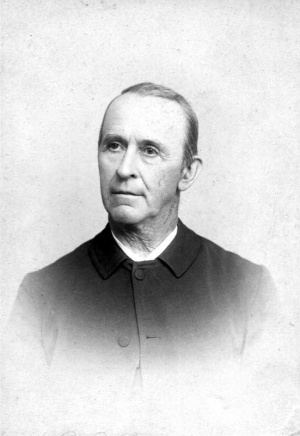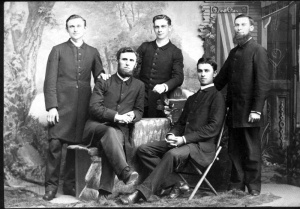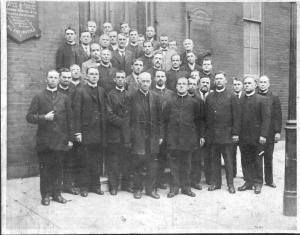Difference between revisions of "Bible Fellowship Church"
| [checked revision] | [checked revision] |
GameoAdmin (talk | contribs) (CSV import - 20130823) |
m (Text replace - "<strong>Address</strong>:" to "'''Address''':") |
||
| (7 intermediate revisions by the same user not shown) | |||
| Line 1: | Line 1: | ||
__FORCETOC__ | __FORCETOC__ | ||
__TOC__ | __TOC__ | ||
| − | + | = 1957 Article = | |
| + | [[File:Gehman-William-234.jpg|300px|thumb|right|''William Gehman, an early leader in Pennsylvania.<br /> | ||
| + | Photo courtesy Bible Fellowship Church Historical Committee.'']] | ||
| + | The Mennonite Brethren in Christ Church of Pennsylvania (became the Bible Fellowship Church in 1959) was the body which continued the denominational name after the General Conference of the [[Mennonite Brethren in Christ|Mennonite Brethren in Christ]] (MBC) on 3 November 1947 changed its name to [[United Missionary Church|United Missionary Church]]. The group, formerly the Pennsylvania Conference of the Mennonite Brethren in Christ, had a continuing organized existence since 1857, when it separated from the [[Eastern District Conference (Mennonite Church USA)|East Pennsylvania Conference of the Mennonite Church]] (which later became a founding conference of the [[General Conference Mennonite Church (GCM)|General Conference Mennonite Church]]), led by [[Oberholtzer, John H. (1809-1895)|John H. Oberholtzer]], and called itself the <em>Evangelische Mennoniten Gemeinschaft</em> or simply the [[Evangelical Mennonite Society|Evangelical Mennonites]]. Although the 1947 MBC General Conference voted a paragraph of the name-changing resolution which said, "One Annual Conference, the Pennsylvania, did not concur in the necessity for the present change in the church name, and was voted full and unqualified relationship to the General Conference of the body, while it continues to use the name Mennonite Brethren in Christ," the separation was in fact complete and the Pennsylvania Conference no longer sent delegates or exercised any fraternal relations to the General Conference of the United Missionary Church (UMC). Thus one of the component parts of the UMC body, which had merged with the United Mennonite Church (at a special conference on 6 November 1879 at [[Upper Milford Mennonite Church (Zionsville, Pennsylvania, USA)|Upper Milford]], Pennsylvania, when it had nine congregations with 175 members) to form the [[Evangelical United Mennonites|Evangelical United Mennonites]], withdrew after 68 years of collaboration and reverted to independent status. The basic causes for the separation in 1947 were differences in polity and administration, but there was apparently also a doctrinal difference. The Pennsylvania Conference had gradually accepted a degree of Calvinist theology, particularly the doctrine of eternal security, whereas the rest of the United Missionary Church continued on its original Wesleyan [[Arminianism|Arminian]] basis, with the emphasis on the "second work of grace." However, for some years the fellowship had become increasingly less close, with practically no interchange of ministers. The Pennsylvania Conference had long had its own independent foreign and home mission boards and Bible school. | ||
| − | + | [[File:Reading-Preachers-26.jpg|300px|thumb|right|''Pennsylvania Conference of the Mennonite Brethren in Christ pastors, ca. 1884-1885 at Reading, Pennsylvania.<br /> | |
| − | + | Photo courtesy Bible Fellowship Church Historical Committee. '']] | |
| − | + | At the time of the separation in 1947 the Pennsylvania Conference had 38 congregations (officially called "appointments"), each with a responsible pastor, organized into two districts, Allentown and Bethlehem, each with a [[District Superintendent|district superintendent]], with 2,340 and 2,177 baptized members respectively. In addition to these there were six appointments under the Home Mission Society and 22 missionaries, with 88 additional members, for a total of 4,605 members. In 1955 the Conference had 4,635 members. All of the congregations were in Eastern [[Pennsylvania (USA)|Pennsylvania]] except three in New Jersey ([[Jersey City Mennonite Brethren in Christ Church (Jersey City, New Jersey, USA) |Jersey City]], [[Newark Mennonite Brethren in Christ Church (Newark, New Jersey, USA)|Newark]], and [[Bible Fellowship Church of Staten Island (Staten Island, New York, USA)|Staten Island]]), which had a total of 337 members. | |
| − | |||
| − | |||
| − | |||
| − | [[File:Reading-Preachers-26.jpg|300px|thumb|right|''Pennsylvania Conference of the Mennonite Brethren in Christ pastors, | ||
| − | |||
| − | ca. 1884-1885 at Reading, Pennsylvania. | ||
| − | |||
| − | Photo courtesy Bible Fellowship Church Historical Committee. '']] | ||
The Conference had an extensive series of subsidiary organizations: Board of Foreign Missions (which supported Mennonite Brethren in Christ missionaries under other boards but operated no foreign work itself), the Board of Home Missions and the Home Missionary Society, the Board of Publications and Printing, the Board of Education, which operated the [[Berean Bible School (Allentown, Pennsylvania, USA)|Berean Bible School]] in [[Allentown (Pennsylvania, USA)|Allentown, Pennsylvania]] after 1950, the Beneficiary Society, the Home and Farm at Center Valley, Pennsylvania, the Laymen's Benevolent Society, the Ministers' Retirement Fund, the Menno Youth General Committee, and several annual [[Camp Meetings|Camp Meetings]], Sunday School Conventions, and an annual Ministerial Convention. | The Conference had an extensive series of subsidiary organizations: Board of Foreign Missions (which supported Mennonite Brethren in Christ missionaries under other boards but operated no foreign work itself), the Board of Home Missions and the Home Missionary Society, the Board of Publications and Printing, the Board of Education, which operated the [[Berean Bible School (Allentown, Pennsylvania, USA)|Berean Bible School]] in [[Allentown (Pennsylvania, USA)|Allentown, Pennsylvania]] after 1950, the Beneficiary Society, the Home and Farm at Center Valley, Pennsylvania, the Laymen's Benevolent Society, the Ministers' Retirement Fund, the Menno Youth General Committee, and several annual [[Camp Meetings|Camp Meetings]], Sunday School Conventions, and an annual Ministerial Convention. | ||
| Line 19: | Line 14: | ||
The conference was thoroughly organized, was aggressively evangelistic, fundamentalistic, and premillennial in doctrinal emphasis, and emphasized a warm type of piety. It recognized the nonresistant position, but not many of its young men took the conscientious objection position and there was no conference discipline on this point. | The conference was thoroughly organized, was aggressively evangelistic, fundamentalistic, and premillennial in doctrinal emphasis, and emphasized a warm type of piety. It recognized the nonresistant position, but not many of its young men took the conscientious objection position and there was no conference discipline on this point. | ||
| − | [[File:199%20Annual%20Conference%201913%201.jpg|300px|thumb|right|''Pennsylvania Conference of the Mennonite Brethren in Christ Annual | + | [[File:199%20Annual%20Conference%201913%201.jpg|300px|thumb|right|''Pennsylvania Conference of the Mennonite Brethren in Christ Annual Conference at Reading, Pennsylvania, 1913.<br /> |
| − | + | Photo courtesy Bible Fellowship Church Historical Committee.'']] | |
| − | Conference at Reading, Pennsylvania, 1913. | + | With the exception of the <em>Eastern Gospel Banner</em> (published sporadically 1917-1924), the Conference never had its own periodical organ, but beginning with 7 March 1953 it had a four-page weekly news supplement to the <em>Gospel Herald </em>published by the [[Union Gospel Press (Cleveland, Ohio, USA)|Union Gospel Press]] at [[Cleveland (Ohio, USA)|Cleveland]], [[Ohio (USA)|Ohio]]. The Conference had a friendly relation to this publishing house and its periodical, the publishing house having been founded by a leading minister of the Conference, [[Musselman, William Brunner (1860-1938)|W. B. Musselman]]. The Conference long used its Sunday-school helps. Dependence on the Union Gospel Press ultimately faded. In 2010 the denomination published a periodical entitled <em>Fellowship News</em>. |
| − | |||
| − | Photo courtesy Bible Fellowship Church Historical Committee.'']] | ||
On 11 April 1959 the conference adopted the name, Bible Fellowship Church. The vote for the new name in the congregations was 1,580 for and 507 against the proposition, while in the conference 56 ministers and delegates approved it and 6 opposed. -- <em>Harold S. Bender & Melvin Gingerich</em> | On 11 April 1959 the conference adopted the name, Bible Fellowship Church. The vote for the new name in the congregations was 1,580 for and 507 against the proposition, while in the conference 56 ministers and delegates approved it and 6 opposed. -- <em>Harold S. Bender & Melvin Gingerich</em> | ||
| − | + | = 2010 Update = | |
| + | Following its separation and assumption of a new name, the Bible Fellowship Church began a process of re-thinking what had been called its "Doctrines and Disciplines." During the 1960s, the church reconsidered its doctrinal statements, giving explicit expression to the Reformed theology which had been growing within it. During the 1970s, the church redesigned its leadership structure to move away from the central authority of a district superintendent to the shared leadership principles inherent in the biblical teaching of rule by elders. In the 1990s, the church re-examined its statements with regard to lifestyle issues to bring them in line with what it considered to be proper biblical positions. | ||
While many changes occurred during these decades, what remained constant was an aggressive international and domestic mission program. The church continued to support missionaries around the world. The church planting ministry continued to begin new churches in America. In recent years, the church included a focus on cross-cultural ministry among ethnic groups in America. The church has become international with the addition of a congregation in [[Mexico|Mexico]]. | While many changes occurred during these decades, what remained constant was an aggressive international and domestic mission program. The church continued to support missionaries around the world. The church planting ministry continued to begin new churches in America. In recent years, the church included a focus on cross-cultural ministry among ethnic groups in America. The church has become international with the addition of a congregation in [[Mexico|Mexico]]. | ||
| Line 43: | Line 37: | ||
<em>Verhandlungen (1859-1895): proceedings of the Evangelical Mennonite Society, also known as the Mennonite Brethren in Christ, now known as the Bible Fellowship Church</em>. Coopersburg, PA : Historical Committee of the Bible Fellowship Church, 1989. | <em>Verhandlungen (1859-1895): proceedings of the Evangelical Mennonite Society, also known as the Mennonite Brethren in Christ, now known as the Bible Fellowship Church</em>. Coopersburg, PA : Historical Committee of the Bible Fellowship Church, 1989. | ||
= Additional Information = | = Additional Information = | ||
| − | + | '''Address''': 3000 Fellowship Drive, Whitehall, PA 18052 | |
| − | + | '''Phone''': 888-724-5325, ext 706 | |
| − | + | '''Website''': [http://www.bfc.org/ Bible Fellowship Church] | |
| − | {{GAMEO_footer|hp=Vol. 3, pp. 603-604; vol. 4, p. 1066|date=October 2010|a1_last=Bender|a1_first=Harold S. | + | {{GAMEO_footer-3|hp=Vol. 3, pp. 603-604; vol. 4, p. 1066|date=October 2010|a1_last=Bender|a1_first=Harold S.|a2_last=Gingerich|a2_first=Melvin|a3_last=Taylor|a3_first=Richard}} |
| + | [[Category:Denominations]] | ||
Latest revision as of 22:36, 8 November 2016
1957 Article
The Mennonite Brethren in Christ Church of Pennsylvania (became the Bible Fellowship Church in 1959) was the body which continued the denominational name after the General Conference of the Mennonite Brethren in Christ (MBC) on 3 November 1947 changed its name to United Missionary Church. The group, formerly the Pennsylvania Conference of the Mennonite Brethren in Christ, had a continuing organized existence since 1857, when it separated from the East Pennsylvania Conference of the Mennonite Church (which later became a founding conference of the General Conference Mennonite Church), led by John H. Oberholtzer, and called itself the Evangelische Mennoniten Gemeinschaft or simply the Evangelical Mennonites. Although the 1947 MBC General Conference voted a paragraph of the name-changing resolution which said, "One Annual Conference, the Pennsylvania, did not concur in the necessity for the present change in the church name, and was voted full and unqualified relationship to the General Conference of the body, while it continues to use the name Mennonite Brethren in Christ," the separation was in fact complete and the Pennsylvania Conference no longer sent delegates or exercised any fraternal relations to the General Conference of the United Missionary Church (UMC). Thus one of the component parts of the UMC body, which had merged with the United Mennonite Church (at a special conference on 6 November 1879 at Upper Milford, Pennsylvania, when it had nine congregations with 175 members) to form the Evangelical United Mennonites, withdrew after 68 years of collaboration and reverted to independent status. The basic causes for the separation in 1947 were differences in polity and administration, but there was apparently also a doctrinal difference. The Pennsylvania Conference had gradually accepted a degree of Calvinist theology, particularly the doctrine of eternal security, whereas the rest of the United Missionary Church continued on its original Wesleyan Arminian basis, with the emphasis on the "second work of grace." However, for some years the fellowship had become increasingly less close, with practically no interchange of ministers. The Pennsylvania Conference had long had its own independent foreign and home mission boards and Bible school.
At the time of the separation in 1947 the Pennsylvania Conference had 38 congregations (officially called "appointments"), each with a responsible pastor, organized into two districts, Allentown and Bethlehem, each with a district superintendent, with 2,340 and 2,177 baptized members respectively. In addition to these there were six appointments under the Home Mission Society and 22 missionaries, with 88 additional members, for a total of 4,605 members. In 1955 the Conference had 4,635 members. All of the congregations were in Eastern Pennsylvania except three in New Jersey (Jersey City, Newark, and Staten Island), which had a total of 337 members.
The Conference had an extensive series of subsidiary organizations: Board of Foreign Missions (which supported Mennonite Brethren in Christ missionaries under other boards but operated no foreign work itself), the Board of Home Missions and the Home Missionary Society, the Board of Publications and Printing, the Board of Education, which operated the Berean Bible School in Allentown, Pennsylvania after 1950, the Beneficiary Society, the Home and Farm at Center Valley, Pennsylvania, the Laymen's Benevolent Society, the Ministers' Retirement Fund, the Menno Youth General Committee, and several annual Camp Meetings, Sunday School Conventions, and an annual Ministerial Convention.
The conference was thoroughly organized, was aggressively evangelistic, fundamentalistic, and premillennial in doctrinal emphasis, and emphasized a warm type of piety. It recognized the nonresistant position, but not many of its young men took the conscientious objection position and there was no conference discipline on this point.
With the exception of the Eastern Gospel Banner (published sporadically 1917-1924), the Conference never had its own periodical organ, but beginning with 7 March 1953 it had a four-page weekly news supplement to the Gospel Herald published by the Union Gospel Press at Cleveland, Ohio. The Conference had a friendly relation to this publishing house and its periodical, the publishing house having been founded by a leading minister of the Conference, W. B. Musselman. The Conference long used its Sunday-school helps. Dependence on the Union Gospel Press ultimately faded. In 2010 the denomination published a periodical entitled Fellowship News.
On 11 April 1959 the conference adopted the name, Bible Fellowship Church. The vote for the new name in the congregations was 1,580 for and 507 against the proposition, while in the conference 56 ministers and delegates approved it and 6 opposed. -- Harold S. Bender & Melvin Gingerich
2010 Update
Following its separation and assumption of a new name, the Bible Fellowship Church began a process of re-thinking what had been called its "Doctrines and Disciplines." During the 1960s, the church reconsidered its doctrinal statements, giving explicit expression to the Reformed theology which had been growing within it. During the 1970s, the church redesigned its leadership structure to move away from the central authority of a district superintendent to the shared leadership principles inherent in the biblical teaching of rule by elders. In the 1990s, the church re-examined its statements with regard to lifestyle issues to bring them in line with what it considered to be proper biblical positions.
While many changes occurred during these decades, what remained constant was an aggressive international and domestic mission program. The church continued to support missionaries around the world. The church planting ministry continued to begin new churches in America. In recent years, the church included a focus on cross-cultural ministry among ethnic groups in America. The church has become international with the addition of a congregation in Mexico.
In 2010, the Bible Fellowship Church consisted of approximately 65 churches with nearly 7700 members. More than 120 ordained pastors served those congregations. Approximately 90 missionary and candidate families served with the support of the church. The Church also maintained Victory Valley Camp, a ministry to children and teens located near Allentown, Pennsylvania, and Pinebrook Bible Conference, a retreat and summer conference for families near Stroudsburg, Pennsylvania. -- Richard Taylor
Bibliography
Bible Fellowship Church On Line History Center. Web. 21 October 2010.
Buck, Leonard E., ed. "What Mean These Stones?" Coopersburg, PA: Historical Committee of the Bible Fellowship Church, 1983.
Minutes of the General Conferences of the Mennonite Brethren in Christ, 1879-1916. Wallingford, PA: Historical Committee of the Bible Fellowship Church, n.d.
Shelly, Harold Patton. The Bible Fellowship Church: formerly Mennonite Brethren in Christ, Pennsylvania Conference, originally die Evangelische Mennoniten Gemeinschaft von Ost-Pennsylvanien. Bethlehem, PA : Historical Committee of the Bible Fellowship Church, 1992.
Verhandlungen (1859-1895): proceedings of the Evangelical Mennonite Society, also known as the Mennonite Brethren in Christ, now known as the Bible Fellowship Church. Coopersburg, PA : Historical Committee of the Bible Fellowship Church, 1989.
Additional Information
Address: 3000 Fellowship Drive, Whitehall, PA 18052
Phone: 888-724-5325, ext 706
Website: Bible Fellowship Church
| Author(s) | Harold S. Bender |
|---|---|
| Melvin Gingerich | |
| Richard Taylor | |
| Date Published | October 2010 |
Cite This Article
MLA style
Bender, Harold S., Melvin Gingerich and Richard Taylor. "Bible Fellowship Church." Global Anabaptist Mennonite Encyclopedia Online. October 2010. Web. 12 Dec 2024. https://gameo.org/index.php?title=Bible_Fellowship_Church&oldid=139810.
APA style
Bender, Harold S., Melvin Gingerich and Richard Taylor. (October 2010). Bible Fellowship Church. Global Anabaptist Mennonite Encyclopedia Online. Retrieved 12 December 2024, from https://gameo.org/index.php?title=Bible_Fellowship_Church&oldid=139810.
Adapted by permission of Herald Press, Harrisonburg, Virginia, from Mennonite Encyclopedia, Vol. 3, pp. 603-604; vol. 4, p. 1066. All rights reserved.
©1996-2024 by the Global Anabaptist Mennonite Encyclopedia Online. All rights reserved.



